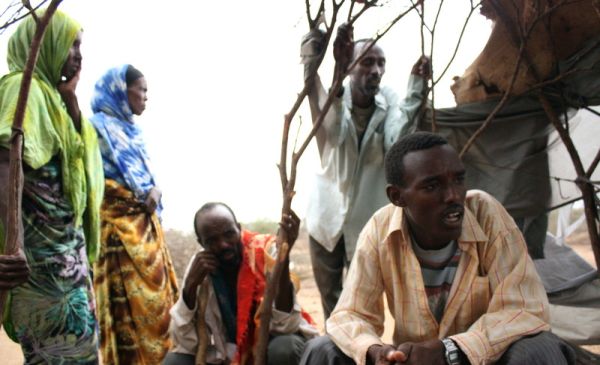
By Oxfam intern, Sophie McGrath, in Addis Ababa
For a village in drought-hit Ethiopia, a single new borehole can change people’s lives.
Hindeysa is a remote community in Somali region of eastern Ethiopia – so remote, in fact, that we get lost weaving between sparse trees, looking for signs of life amongst sandy red earth. And it’s not the only thing around here that’s hard to find — with unusually bad drought affecting the whole region this year, water is in ever-shorter supply.
Shamsedin Afen, 20, tells us what this has meant for his family: his parents, sister and three brothers. “We cultivate the land, growing maize and sorghum, and keep livestock. We have forty sheep, goats and cows.” But, their crops failing without rain, the family are relying on the food they stored from last year to see them through. Their animals are not so lucky. “We couldn’t cultivate enough forage this year to feed them – we’ve lost thirteen sheep and goats.”
For Hawa Abdulayi, the situation is even worse. “I only had twenty sheep and goats, and it’s killed ten.” As households run by women tend to be poorer and have fewer animals, drought can hit them especially hard.
There are other, routine losses, too. “Every day we lose six hours,” says Shamsedin – the time, he explains, it takes to fetch water from the nearest source, the town of Dembel. “We don’t have a storage system, so we have to go each day.” What’s more, this water is only enough for people to drink. “The situation for the animals is very different – we can’t provide for them too, so we just leave them and return in the afternoon.”
A reliable source of water
But in a few days, this will all change. For the last five months, Oxfam, with the community’s help, has been building a borehole here, and when the finishing touches are completed, they will have a reliable source of abundant water – five litres per second, in fact.
“A better life will come,” says Shamsedin confidently. “This will benefit both the people and the animals – not only here, but also in the surrounding communities.” He estimates that the water will improve the lives of 8,000 people in total.
He anticipates not just that he and his animals will have enough to drink, or that the daily trek will be over – but the possibility of long-term benefits to his farming from irrigation. “We have a lot of resources that without water we can’t use. With water, we can finally exploit these. We can grow vegetables, potato, tomato, watermelon, papaya, guava.”
For Hawa, the pump is most of all a lifeline. “I was planning to migrate to another place, but this has revived my hope of staying here.”
The community has helped in the construction however they can – cooking for the workers, fetching water from Dembel for them, and cutting trees and clearing an area to make them a shelter out of branches. When the pump’s finished, they plan to contribute money to help maintain it and form a committee to make sure it’s kept clean and hygienic.
When the pump was tested and water came out, “we had a huge ceremony,” says Shamsedin.
“Water is at the frontline of life,” adds Ali-Dahir Muhammed, another resident of Hindeysa.
Now, it’s a line people here won’t have to cross.
Find out more
- Learn more about the situation in East Africa, and what Oxfam is doing
- Donate to our East Africa food crisis appeal and save lives